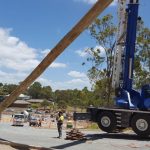
How Close Can a Crane Be Set Up Near an Excavation or Trench?
Operating a mobile crane near an excavation or trench comes with significant risks. If not properly assessed, the ground around the excavation can collapse, leading to instability, potential overturning, and serious safety hazards. Understanding the risks and following best practices ensures a safer worksite and prevents costly accidents.
***
The information provided in this article is for general guidance only and should not replace site-specific assessments conducted by qualified professionals. Ground conditions, excavation stability, and crane positioning must be evaluated on a case-by-case basis to ensure compliance with safety regulations and manufacturer guidelines. Improper setup near an excavation can result in serious hazards, including crane overturning and trench collapse.
Need expert advice? At Mighty Cranes, we offer free site visits and lift plans to ensure your crane operation is safe, efficient, and fully compliant with industry standards. Our experienced team will assess your worksite conditions and provide a tailored lifting solution. Call us today at 0477 000 976 to schedule your free site assessment and lift plan!
***
Risks of Placing a Crane Near an Excavation
Cranes exert significant pressure on the ground, and when positioned near an excavation, they can contribute to trench wall collapse. The following factors increase the risk:
Ground Softness and Stability
- Loose, crumbling, or backfilled soil lacks the strength to support the crane’s weight.
- Groundwater or muddy conditions can further weaken the soil, increasing instability.
Trench Wall Collapse
- Vertical excavation walls are more prone to sudden collapse than those that are battered back at an angle.
- A phenomenon known as “slippery back”, where natural fractures in the soil create weak points, can cause unexpected trench collapses.
Overturning Risks
- If the crane is too close to an unstable excavation, the shifting ground can cause the crane to tip.
- The movement of the crane’s outriggers can put additional stress on weak ground, leading to failure.
Safe Distance Guidelines for Cranes Near Excavations
To ensure stability, mobile cranes should be positioned at a safe distance from excavations. The recommended distances depend on the ground conditions:
If at any point you are unsure of the correct location or procedure a competent person should be engaged e.g a geotechnical engineer.
Stable, Compact Ground:
If the ground is firm and not crumbling, the 1:1 rule should be followed. This means:
- The crane’s outrigger support dunnage should be set back from the excavation at least the same distance as the depth of the trench.
- Example: If an excavation is 3 metres deep, the crane should be positioned at least 3 metres away from the edge.
Loose, Backfilled, or Crumbling Ground:
- If the excavation site consists of loose or recently backfilled material, the 1:1 rule may not be sufficient.
- In such cases, a competent person e.g a geotechnical engineer should assess the site to determine the appropriate distance based on soil conditions and load-bearing capacity.
Best Practices for Crane Operation Near Excavations
Conduct a Thorough Site Assessment
- Inspect the ground for signs of instability, including cracks, soft spots, or water seepage.
- If uncertain, consult a geotechnical engineer for a professional evaluation.
Follow Proper Setup Procedures
- Always extend outriggers fully and use stabilising mats or pads where necessary.
- Avoid positioning outriggers directly above underground utilities, which may cause unexpected ground shifts.
Monitor Ground Conditions During Operation
- Changes in moisture levels, unexpected vibrations, or nearby excavation activities can alter ground stability.
- Pause operations if signs of shifting ground appear.
Use Protective Measures for Trench Stability
- Shoring or trench boxes can reinforce excavation walls, reducing the risk of collapse.
- Benching or sloping excavation sides can improve stability compared to vertical trench walls.
Expert Assessment Is Essential
Setting up a crane near an excavation or trench requires careful planning, proper site evaluation, and adherence to safe distance guidelines. The 1:1 rule is a good starting point for firm ground, but when dealing with loose or backfilled soil, expert assessment is essential. By following these best practices, construction teams can prevent accidents, protect personnel, and ensure a stable, efficient lifting operation.
Request A Free Site Visit and Lift Plan
Looking for a reliable crane hire company in Brisbane? At Mighty Cranes, we prioritise safety and efficiency in every lift. Our team of experienced Brisbane crane operators ensures that cranes are positioned and operated according to best practices, even in challenging environments like excavations and trenches. Contact Mighty Cranes today at 0477 000 976 to discuss your lifting needs with our experts.




